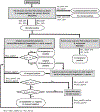A molecular algorithm to detect and differentiate human pathogens infecting Ixodes scapularis and Ixodes pacificus (Acari: Ixodidae)
- PMID: 29258802
- PMCID: PMC6452875
- DOI: 10.1016/j.ttbdis.2017.12.005
A molecular algorithm to detect and differentiate human pathogens infecting Ixodes scapularis and Ixodes pacificus (Acari: Ixodidae)
Abstract
The incidence and geographic range of tick-borne illness associated with Ixodes scapularis and Ixodes pacificus have dramatically increased in recent decades. Anaplasmosis, babesiosis, and Borrelia spirochete infections, including Lyme borreliosis, account for tens of thousands of reported cases of tick-borne disease every year. Assays that reliably detect pathogens in ticks allow investigators and public health agencies to estimate the geographic distribution of human pathogens, assess geographic variation in their prevalence, and evaluate the effectiveness of prevention strategies. As investigators continue to describe new species within the Borrelia burgdorferi sensu lato complex and to recognize some Ixodes-borne Borrelia species as human pathogens, assays are needed to detect and differentiate these species. Here we describe an algorithm to detect and differentiate pathogens in unfed I. scapularis and I. pacificus nymphs including Anaplasma phagocytophilum, Babesia microti, Borrelia burgdorferi sensu stricto, Borrelia mayonii, and Borrelia miyamotoi. The algorithm comprises 5 TaqMan real-time polymerase chain reaction assays and 3 sequencing protocols. It employs multiple targets for each pathogen to optimize specificity, a gene target for I. scapularis and I. pacificus to verify tick-derived DNA quality, and a pan-Borrelia target to detect Borrelia species that may emerge as human disease agents in the future. We assess the algorithm's sensitivity, specificity, and performance on field-collected ticks.
Keywords: Anaplasma phagocytophilum; Babesia microti; Borrelia; Ixodes; Real-time PCR.
Published by Elsevier GmbH.
Figures

Similar articles
-
Evaluation of a novel multiplex PCR amplicon sequencing assay for detection of human pathogens in Ixodes ticks.Ticks Tick Borne Dis. 2020 Nov;11(6):101504. doi: 10.1016/j.ttbdis.2020.101504. Epub 2020 Jul 2. Ticks Tick Borne Dis. 2020. PMID: 32993925 Free PMC article.
-
Prevalence of Infection and Co-Infection and Presence of Rickettsial Endosymbionts in Ixodes Scapularis (Acari: Ixodidae) in Connecticut, USA.J Parasitol. 2020 Feb;106(1):30-37. J Parasitol. 2020. PMID: 31971489
-
Prevalence and distribution of seven human pathogens in host-seeking Ixodes scapularis (Acari: Ixodidae) nymphs in Minnesota, USA.Ticks Tick Borne Dis. 2018 Sep;9(6):1499-1507. doi: 10.1016/j.ttbdis.2018.07.009. Epub 2018 Jul 20. Ticks Tick Borne Dis. 2018. PMID: 30055987 Free PMC article.
-
Pathogen transmission in relation to duration of attachment by Ixodes scapularis ticks.Ticks Tick Borne Dis. 2018 Mar;9(3):535-542. doi: 10.1016/j.ttbdis.2018.01.002. Epub 2018 Jan 31. Ticks Tick Borne Dis. 2018. PMID: 29398603 Free PMC article. Review.
-
The Blacklegged Tick, Ixodes scapularis: An Increasing Public Health Concern.Trends Parasitol. 2018 Apr;34(4):295-309. doi: 10.1016/j.pt.2017.12.006. Epub 2018 Jan 11. Trends Parasitol. 2018. PMID: 29336985 Free PMC article. Review.
Cited by
-
Invasive Haemaphysalis longicornis (Acari: Ixodidae) investigation in South Carolina: new records of establishment, pathogen prevalence, and blood meal analyses.J Med Entomol. 2023 Nov 14;60(6):1398-1405. doi: 10.1093/jme/tjad119. J Med Entomol. 2023. PMID: 37658780 Free PMC article.
-
Reported County-Level Distribution of Lyme Disease Spirochetes, Borrelia burgdorferi sensu stricto and Borrelia mayonii (Spirochaetales: Spirochaetaceae), in Host-Seeking Ixodes scapularis and Ixodes pacificus Ticks (Acari: Ixodidae) in the Contiguous United States.J Med Entomol. 2021 May 15;58(3):1219-1233. doi: 10.1093/jme/tjaa283. J Med Entomol. 2021. PMID: 33600574 Free PMC article.
-
Prevalence of five human pathogens in host-seeking Ixodes scapularis and Ixodes pacificus by region, state, and county in the contiguous United States generated through national tick surveillance.Ticks Tick Borne Dis. 2023 Nov;14(6):102250. doi: 10.1016/j.ttbdis.2023.102250. Epub 2023 Sep 11. Ticks Tick Borne Dis. 2023. PMID: 37703795 Free PMC article.
-
Passerine birds as hosts for Ixodes ticks infected with Borrelia burgdorferi sensu stricto in southeastern Virginia.Ticks Tick Borne Dis. 2021 May;12(3):101650. doi: 10.1016/j.ttbdis.2021.101650. Epub 2021 Jan 12. Ticks Tick Borne Dis. 2021. PMID: 33486431 Free PMC article.
-
Release the hens: a study on the complexities of guinea fowl as tick control.J Med Entomol. 2024 Mar 13;61(2):410-417. doi: 10.1093/jme/tjad167. J Med Entomol. 2024. PMID: 38279688 Free PMC article.
References
-
- Adams DA, Thomas KR, Jajosky RA, Foster L, Sharp P, Onweh DH, Schley AW, Anderson WJ, 2016. Summary of notifiable infectious diseases and conditions – United States, 2014. MMWR Morb. Mortal. Wkly. Rep 63, 1–152. - PubMed
-
- Bacon RM, Pilgard MA, Johnson BJ, Piesman J, Biggerstaff BJ, Quintana M, 2005. Rapid detection methods and prevalence estimation for Borrelia lonestari glpQ in Amblyomma americanum (Acari: Ixodidae) pools of unequal size. Vector-Borne Zoon. Dis 5, 146–156. - PubMed
-
- Bakken JS, Dumler S, 2008. Human granulocytic anaplasmosis. Inf. Dis. Clin. N. Am 22, 433–448. - PubMed
-
- Belongia EA, Reed KD, Mitchell PD, Chyou PH, Mueller-Rizner N, Finkel MF, Schriefer ME, 1999. Clinical and epidemiological features of early Lyme disease and human granulocytic ehrlichiosis in Wisconsin. Clin. Infect. Dis 29, 1472–1477. - PubMed
MeSH terms
Grants and funding
LinkOut - more resources
Full Text Sources
Other Literature Sources
Research Materials

